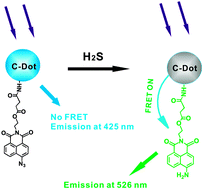Carbon-dot-based ratiometric fluorescent sensor for detecting hydrogen sulfide in aqueous media and inside live cells†
Abstract
A FRET ratiometric fluorescent sensor was developed for detecting H2S in aqueous media and serum, as well as inside live cells. For this sensor, carbon dots serve as the energy donor and also the anchoring site for the probe. This sensor is highly selective and sensitive with a detection limit of 10 nM which is the lowest among fluorescent H2S sensors.


 Please wait while we load your content...
Please wait while we load your content...